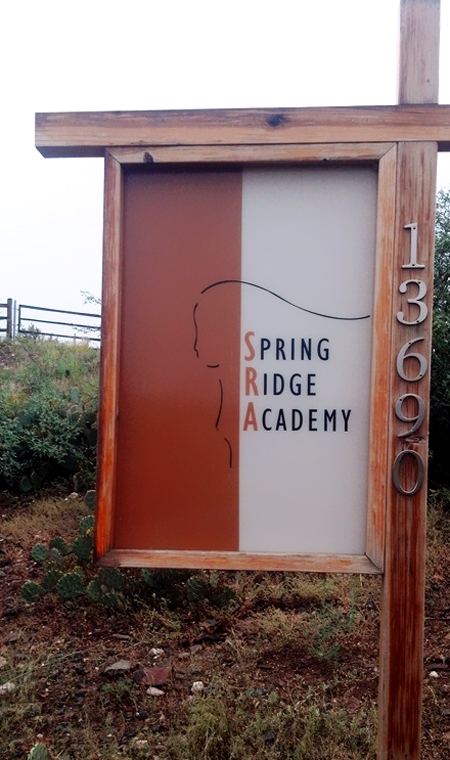| From Strugglingteens.com Visit Reports Spring Valley, AZ Spring Ridge Academy is a therapeutic boarding school for girls on the outskirts of the small community of Spring Valley, Arizona, not far from Sedona. It maintains a low profile and at first glance looks like one of the farms they are surrounded by. I drove right past it at first and had to turn around. I noticed the school sign at the entrance to the school near the art/dance building and the athletic field.
The school has a capacity of 72 girls with 55 there on the day of my visit. That number continually changes because they have rolling admissions and placement is not restricted to the academic year. The buildings were modern and comfortable, having more a home like environment than anything else. The girls seemed comfortable and relaxed with a good sense of emotional safety. Most of the activity I saw was typical of any groups of students. They were visiting, walking together to and from classes and conferring with teachers. The ones I saw in class were attentive and interacting with the teachers regarding the subject matter or perhaps some personal issue. The staff lined me up with a few girls to have lunch with and the girls were open about how they came to be at Spring Ridge, issues they were working on, hopes for the future etc. During lunch some students had to leave and others stopped by to replace them. The students seemed to be conscious of their role as hostesses and were making sure I wasn't left untended. Finally only one girl was left, and she told me she had to go to class but didn't want to leave me by myself. I assured her that the staff was keeping a good eye on me and I wouldn't be lonely, so she thanked me and scooted off to her class. The school describes itself as an "empowering emotional growth program with a sophisticated therapeutic approach and a rigorous college prep curriculum." The structure of an emotional growth program was obvious. At all times, the girls were intent on doing what was scheduled, with the breaks for relaxing time being adequate but not too long. I saw several conversations girls were having with staff that appeared to be focused on some action and consequences along with it being a learning moment. They are a family systems program and contact with parents and helping the parents was explained to me as a priority. During the girl's stay there they attend four experiential educational workshops. The parents attend one workshop for themselves, and then two family workshops that include siblings. The last family workshop is oriented toward transition which focuses on the future and what the girls and their parents need to do to continue their growth. Most of the students come there immediately after a therapeutic wilderness experience. This shortens the first phase compared to other schools, the orientation phase, since much of the preliminary work has been done and the girls are already used to the structure necessary for an emotional growth program. There are three more phrases, with the fourth consisting of work the family needs to do when the girl is back home in continuing to work on whatever major issues the student has relating to relationships, sobriety, body image, anxiety, adoption etc. From what I saw in the classrooms, the school takes seriously their goal of providing a rigorous college prep curriculum. The school is a SAT and ACT testing site, and the materials I had a chance to look at looked challenging. It contains a full CORE curriculum, classes are typically 8-10 students with teachers certified in the subjects. The academic department is also an integral part of the treatment team, to ensure that academics are treated as important as the rest of the program. Staff informed me that in the students enrolled, they are seeing an increase in girls with trauma, attachment, sexual, anxiety and LD issues. I think it would be fair to say that the school is seeing more damaged girls than would have been typical a decade or so ago. Along with the mentoring by staff, the school has several therapeutic intensives to work with girls with the specific issues of anxiety and depression, chemical dependency, trauma, body image, relationships and new intensives focusing of sexual issues and adoption. They have been adopting several new techniques that are becoming popular nationally. One of those is Dialectical Behavior Therapy (DBT) skills groups, which is mostly known for mindfulness and cognitive-behavioral techniques. The other is Eye Movement Desensitization and Reprocessing (EMDR), which is less known. Gary Hees, Clinical Director explained that EMDR is effective in quickly finding clues and insights to traumas through a technique of eye movement. He explained how using these together is very effective at assessing emotional/behavioral problems through EMDR, which often are followed by therapy utilizing more traditional mindfulness and cognitive-behavioral techniques. My overall impression was that everything at the school was flowing smoothly, what needed to be happening was happening, and I saw no evidence of squirreling around or underground behavior that I usually see in most mainstream schools. © Copyright 2012 by Woodbury Reports, Inc. |
